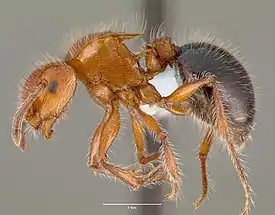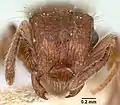Meranoplus
Meranoplus (лат.) — род муравьёв трибы Crematogastrini из подсемейства Myrmicinae (Formicidae).
| Meranoplus | ||||||||||
|---|---|---|---|---|---|---|---|---|---|---|
 Муравей Meranoplus mayri | ||||||||||
| Научная классификация | ||||||||||
|
Домен: Царство: Подцарство: Без ранга: Без ранга: Без ранга: Без ранга: Тип: Подтип: Надкласс: Класс: Подкласс: Инфракласс: Надотряд: Hymenopterida Отряд: Подотряд: Инфраотряд: Надсемейство: Семейство: Подсемейство: Триба: Род: Meranoplus |
||||||||||
| Международное научное название | ||||||||||
| Meranoplus Smith F., 1853 | ||||||||||
| Типовой вид | ||||||||||
|
Cryptocerus bicolor |
||||||||||
| ||||||||||
Распространение
Тропики Старого Света: Афротропика, Мадагаскар, Южная и Юго-Восточная Азия, Австралазия. Наибольшее видовое разнообразие наблюдается в Австралии (более 50 видов)[1][2][3].
Описание
Мелкие муравьи длиной около 3—5 мм. Тело покрыто многочисленными отстоящими волосками. Мандибулы с коротким жевательным краем на котором 4—5 зубцов. Усики рабочих и самок 9-члениковые с булавой из 3 вершинных члеников. У самцов усики 13-члениковые, жвалы с одним зубцом. Максиллярные щупики 5-члениковые, нижнегубные челюстные щупики из 3 члеников. Грудь высокая, пронотум слит с мезонотумом, образуя единый склерит. Мезосома дорозолатерально и часто заднелатерально выступающая. Проподеальные шипы развиты. Петиоль короткий, сидячий, без переднего стебелька. Жало развито. Коконы отсутствуют[1][2][3].
Африканские виды этого рода гнездятся в земле, в гнилой древесине или под камнями. Фуражировка осуществляется в основном на земле или в опаде из листьев, тогда как лишь очень немногие виды могут дополнительно взбираться на деревья или кустарники[1]. Большинство видов являются всеядными и факультативными зерноядными, в то время как другие, включая всю группу видов Meranoplus diversus, являются специализированными зерноядными животными[2]. По крайней мере, один вид, обитающий в тропических лесах Малайзии Meranoplus mucronatus, как известно, имеет трофобиотические взаимоотношения с равнокрылыми насекомыми. Известно, что виды Meranoplus активны как днем, так и ночью, и рекрутируются через феромоновые следы, проложенные основанием жала, используя секреты своих чрезвычайно больших желез Дюфура. Функция лопатообразного жала до сих пор неизвестна. Единственный вид Meranoplus, для которого зарегистрировано спаривание половых особей, — это Meranoplus peringueyi, у которого рои крылатых половых особей, собирающихся для спаривания наблюдались после дождя, и где самцы зигзагообразно патрулировали скопления самок[3].
Когда их потревожат, они впападают в танатозное состояние, проявляют особое поведение «симулируя смерть». Они втягивают усики в усиковые бороздки, засовывают ноги под промезонотальный щит и остаются неподвижными[4][5]. Это поведение усиливается маскировкой, то есть особи накапливают частички грязи в своей внешней волосистой оболочке, что лучше скрывает их, когда они притворяются мертвыми[3]
 Meranoplus radamae
Meranoplus radamae
Систематика
Около 80 видов. Ранее некоторые авторы выделяли род в отдельную трибу Meranoplini или[6] объединялись в сборную группу Cryptoceridae вместе с трибой Cephalotini и родом Cataulacus. В последнее время включают в укрупнённую трибу Crematogastrini[7]. Проведённый в 2018 году молекулярно-филогенетический анализ трибы позволил выделить в этой трибе 10 родовых групп, в том числе Crematogaster genus-group, в которую вошли Crematogaster и род Meranoplus[8].
Виды
- Meranoplus affinis Baroni Urbani, 1971
- Meranoplus ajax Forel, 1915
- Meranoplus angustinodis Schödl, 2007
- Meranoplus arcuatus Schödl, 2007
- Meranoplus armatus Smith, 1862
- Meranoplus astericus Donisthorpe, 1947
- Meranoplus aureolus Crawley, 1921
- Meranoplus barretti Santschi, 1928
- Meranoplus beatoni Taylor, 2006[9]
- Meranoplus bellii Forel, 1902
- Meranoplus berrimah Schödl, 2007
- Meranoplus bicolor (Guérin-Méneville, 1844) typus (=Cryptocerus bicolor)
- Meranoplus biliran Schödl, 1998
- Meranoplus birmanus Schödl, 1999[10]
- Meranoplus boltoni Schödl, 1998
- Meranoplus borneensis Schödl, 1998
- Meranoplus castaneus Smith, 1857
- Meranoplus christinae Schödl, 2007
- Meranoplus clypeatus Bernard, 1953
- Meranoplus convexius Schödl, 2007
- Meranoplus crassispina Schödl, 2007
- Meranoplus cryptomys Boudinot & Fisher, 2013
- Meranoplus curvispina Forel, 1910
- Meranoplus deserticola Schödl, 2007
- Meranoplus dichrous Forel, 1907
- Meranoplus digitatus Schödl, 2007
- Meranoplus dimidiatus Smith, 1867
- Meranoplus discalis Schödl, 2007
- Meranoplus diversoides Schödl, 2007
- Meranoplus diversus Smith, 1867
- Meranoplus dlusskyi Zryanin, 2015
- Meranoplus doddi Santschi, 1928
- Meranoplus duyfkeni Forel, 1915
- Meranoplus excavatus Clark, 1938
- Meranoplus fenestratus Smith, 1867
- Meranoplus ferrugineus Crawley, 1922
- Meranoplus froggatti Forel, 1913
- Meranoplus glaber Arnold, 1926
- Meranoplus hilli Crawley, 1922
- Meranoplus hirsutus Mayr, 1876
- Meranoplus hoplites Taylor, 2006[11][9]
- Meranoplus hospes Forel, 1910
- Meranoplus inermis Emery, 1895
- Meranoplus laeviventris Emery, 1889
- Meranoplus leveillei Emery, 1883
- Meranoplus levis Donisthorpe, 1942
- Meranoplus linae Santschi, 1928
- Meranoplus loebli Schödl, 1998
- Meranoplus magrettii André, 1884
- Meranoplus malaysianus Schödl, 1998
- Meranoplus mars Forel, 1902
- Meranoplus mayri Forel, 1910
- Meranoplus mcarthuri Schödl, 2007
- Meranoplus minimus Crawley, 1922
- Meranoplus minor Forel, 1902
- Meranoplus mjobergi Forel, 1915
- Meranoplus montanus Schödl, 1998
- Meranoplus mosalahi Sharaf, 2019
- Meranoplus mucronatus Smith, 1857
- Meranoplus naitsabes Schödl, 2007
- Meranoplus nanus André, 1892
- Meranoplus nepalensis Schödl, 1998
- Meranoplus niger Donisthorpe, 1949
- Meranoplus occidentalis Schödl, 2007
- Meranoplus oceanicus Smith, 1862
- Meranoplus orientalis Schödl, 2007
- Meranoplus oxleyi Forel, 1915
- Meranoplus parviumgulatus (Donisthorpe, 1947)
- Meranoplus peringueyi Emery, 1886
- Meranoplus periyarensis Bharti & Akbar, 2014
- Meranoplus pubescens (Smith, 1853)
- Meranoplus pulcher Sharaf, 2014
- Meranoplus puryi Forel, 1902[12]
- Meranoplus radamae Forel, 1891
- Meranoplus raripilis Donisthorpe, 1938
- Meranoplus rothneyi Forel, 1902
- Meranoplus rugosus Crawley, 1922
- Meranoplus sabronensis Donisthorpe, 1941
- Meranoplus schoedli Taylor, 2006[9]
- Meranoplus similis Viehmeyer, 1922
- Meranoplus snellingi Schödl, 2007
- Meranoplus spininodis Arnold, 1917
- Meranoplus spinosus Smith, 1859
- Meranoplus sthenus Bolton, 1981
- Meranoplus sylvarius Boudinot & Fisher, 2013
- Meranoplus taurus Schödl, 2007
- Meranoplus testudineus McAreavey, 1956
- Meranoplus tricuspidatus Schödl, 2007
- Meranoplus unicolor Forel, 1902
- Meranoplus variabilis Schödl, 2007
- Meranoplus vestigator Smith, 1876
- Meranoplus wilsoni Schödl, 2007
Примечания
- Bolton B. A revision of the ant genera Meranoplus F. Smith, Dicroaspis Emery and Calyptomyrmex Emery (Hymenoptera: Formicidae) in the Ethiopian zoogeographical region (англ.) // Bull. Br. Mus. (Nat. Hist.) Entomol.. — 1981. — Vol. 42. — P. 43—81.
- Andersen A.N. 2006. A systematic overview of Australian species of the myrmicine ant genus Meranoplus F. Smith, 1853. Myrmecologische Nachrichten 8: 157—170.
- Boudinot Brendon E., Fisher Brian L. A taxonomic revision of the Meranoplus F. Smith of Madagascar (Hymenoptera: Formicidae: Myrmicinae) with keys to species and diagnosis of the males (англ.) // Zootaxa. — 2013. — Vol. 3635. — P. 301–339. — doi:10.11646/zootaxa.3635.4.1. — PMID 26097952.
- Hita Garcia, F.; Wiesel, E.; Fischer, G. 2013. The ants of Kenya (Hymenoptera: Formicidae)—faunal overview, first species checklist, bibliography, accounts for all genera, and discussion on taxonomy and zoogeography. Journal of East African Natural History 101(2):127-222. Published By: Nature Kenya/East African Natural History Society DOI: http://dx.doi.org/10.2982/028.101.0201 URL: http://www.bioone.org/doi/full/10.2982/028.101.0201
- Hölldobler, B. (1988). Chemical communication in Meranoplus (Hymenoptera: Formicidae). Psyche 95: 139—151.
- Smith, F. 1853: Monograph of the genus Cryptocerus, belonging to the group Cryptoceridae — family Myrmicidae — division Hymenoptera Heterogyna. Transactions of the Entomological Society of London, (2)2(1854): 213—228.
- Ward, P. S.; Seán G. Brady; Brian L. Fisher and Ted R. Schultz. The evolution of myrmicine ants: phylogeny and biogeography of a hyperdiverse ant clade (Hymenoptera: Formicidae) (англ.) // Systematic entomology : Журнал. — Лондон: The Royal Entomological Society and John Wiley & Sons, 2014 (2015). — Vol. 40, no. 1. — P. 61—81. — ISSN 0307-6970. — doi:10.1111/syen.12090. (в интернете опубликовано в 2014 году — 23 July 2014, а официальная дата: January 2015, № 1 — 2015)
- Bonnie B Blaimer, Philip S Ward, Ted R Schultz, Brian L Fisher, Seán G Brady. Paleotropical Diversification Dominates the Evolution of the Hyperdiverse Ant Tribe Crematogastrini (Hymenoptera: Formicidae) (англ.) // Insect Systematics and Diversity : Журнал. — США: Entomological Society of America and Oxford University Press, 2018. — Vol. 2, no. 5(3). — P. 1—14. — ISSN 2399-3421. — doi:10.1093/isd/ixy013.
- Taylor, R.W. (2006) Ants of the genus Meranoplus F. Smith, 1853 (Hymenoptera: Formicidae): three new species and others from northeastern Australian rainforests. Myrmecologische Nachrichten, 8, 21–29.
- Schödl S. Description of Meranoplus birmanus sp.nov. from Myanmar, and the first record of M. bicolor from Laos (Hymenoptera: Formicidae) (англ.) // Entomological Problems. — 1999. — Vol. 30, no. 2. — P. 61—65.
- Taylor, R.W. (1990) The nomenclature and distribution of some Australian and New Caledonian ants of the genus Meranoplus Fr. Smith (Hymenoptera: Formicidae: Myrmicinae). General and Applied Entomology, 22, 31–40.
- Schödl, S. (2004) On the taxonomy of Meranoplus puryi Forel, 1902 and Meranoplus puryi curvispina Forel, 1910 (Insecta: Hymenoptera: Formicidae). Annalen des Naturhistorischen Museums in Wien, 105, 349—360.
Литература
- Bolton B. A revision of the ant genera Meranoplus F. Smith, Dicroaspis Emery and Calyptomyrmex Emery (Hymenoptera: Formicidae) in the Ethiopian zoogeographical region (англ.) // Bull. Br. Mus. (Nat. Hist.) Entomol.. — 1981. — Vol. 42. — P. 43—81.
- Schödl S. Taxonomic revision of Oriental Meranoplus F. Smith, 1853 (Hymenoptera: Formicidae: Myrmicidae) (англ.) // Annalen des Naturhistorischen Museums in Wien. — 1998. — Vol. 100. — P. 361—394.
- Schödl S. Revision of Australian Meranoplus: the Meranoplus diversus group. Pages 370—424 in Snelling, R. R., B. L. Fisher and P. S. Ward. Advances in ant systematics (Hymenoptera: Formicidae): Homage to E.O. Wilson — 50 years of contributions (англ.) // Memoirs of the American Entomological Institute. — 2007. — Vol. 80. — P. 370—424.
